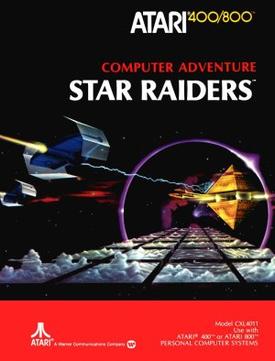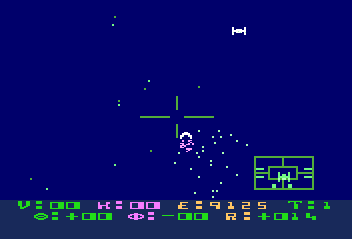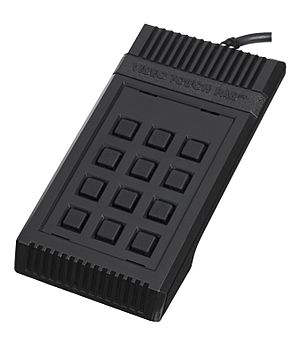Star Raiders facts for kids
Quick facts for kids Star Raiders |
|
|---|---|

Atari 8-bit cover art
|
|
| Developer(s) | Atari, Inc. Atari Corporation (ST) |
| Publisher(s) | Atari, Inc. Atari Corporation (ST) |
| Designer(s) | Doug Neubauer |
| Platform(s) | Atari 8-bit, Atari 2600, Atari 5200, Atari ST |
| Release date(s) | Atari 8-bit
|
| Genre(s) | Space combat simulator |
| Mode(s) | Single-player |
Star Raiders is a classic video game from 1979. It was one of the first games to let you fly a spaceship and fight enemies from a first-person view. This means you see the game through the eyes of your pilot!
The game was made by Doug Neubauer for the Atari 8-bit family of computers. It was so popular that many people called it the "killer app" for the Atari computers. This means it was a game that made people want to buy the computer just to play it! Later, Star Raiders was also released on other Atari game systems like the Atari 2600, Atari 5200, and Atari ST.
In Star Raiders, you fly your spaceship through 3D space. Your mission is to fight off an alien fleet called the "Zylons." The game was special because of its cool graphics. You could see the stars moving as you flew, making it feel like you were really zooming through space!
Many games copied Star Raiders because it was so good. It even inspired famous space games like Elite and Wing Commander. In 2007, experts at Stanford University said Star Raiders was one of the 10 most important video games ever made!
Contents
How to Play Star Raiders
Star Raiders is a space combat game where you control your own spaceship. You move around a large map, fighting enemy ships.
The game has a "Galactic Chart" that looks like a grid. This map shows you different areas, called sectors. Some sectors are empty, while others have enemy ships or friendly "starbases." This chart helps you see where everything is in the galaxy.
You can fly your ship within a sector using your normal engines. But to travel between sectors, you use "hyperspace." This makes the stars stretch out in a cool way, like in the Star Wars movies! On harder levels, you need to be careful when you jump to hyperspace. You have to keep a target in the middle of your screen to arrive exactly where you want to go.
Battles and Ship Management
When you're in a battle, you see the action from inside your ship. You can shoot "photons" at the Zylon ships. These enemy ships come in three different types. They look a bit like ships from other famous space stories like Star Wars and Battlestar Galactica.
There's a small screen in the corner that helps you aim. It shows you where distant enemies are. When your weapons are ready, you can fire two torpedoes at once! There's also a "long-range scan" that acts like a radar. It shows you a top-down view of the area around your ship.
The Zylon enemies include:
- Fighters: These are the standard enemy ships. They look like the TIE fighters from Star Wars.
- Patrol ships: These ships won't shoot at you until you shoot at them first. They look a bit like ships from Battlestar Galactica or Star Trek.
- Basestars: These are the strongest Zylon ships. They glow orange and have shields. You need to hit them many times quickly or get a "Target Lock" to destroy them. When you have a Target Lock, two torpedoes will fire and follow the Basestar until they hit.
You need to be careful because your ship can get damaged. Collisions with space rocks or enemy fire can hurt your shields, engines, weapons, or displays. If your shields are down and you crash, your ship will be destroyed, and the game ends. Running out of energy also ends the game.
You have to manage your ship's energy and fix any damage. You can do this by flying to a friendly starbase. But watch out! The Zylons can also destroy your starbases if they surround them on the Galactic Chart. So, you need to protect your starbases too! All these things made Star Raiders a very deep and exciting game for its time.
How You Win and Get a Rank
Unlike many games back then, you can actually win Star Raiders! You win by destroying all the enemy ships in the galaxy.
The game doesn't show you a score while you play. Instead, when you win, lose, or quit, you get a "rating." This rating is like a military rank, and it comes with a number. If you play really badly, you might get a rank like "Garbage Scow Captain"! But if you play well, you can become a "Star Commander." Your rank depends on how well you played, how much energy and time you used, how many starbases were destroyed, and how many enemies you defeated.
Different Versions of Star Raiders
Star Raiders was made for several different Atari systems. Each version had some unique features.
- Atari 5200 Version: This version came out in 1982. It was very similar to the computer version. It used the 5200's special joystick, which let you turn your ship at different speeds. All the game controls were on the controller's keypad, making it easy to play. This version also had better graphics for the Sector Scan mode, showing small pictures of enemy ships instead of just dots.
- Atari 2600 Version: Released in 1982, this version was made for the Atari 2600, which had simpler graphics and sound. It came with a special controller called the Video Touch Pad, which had a keypad like a computer keyboard. Star Raiders was the only game that really used this special controller. In this version, the Zylons were called "Krylons."
- Atari ST Version: This version came out in 1986 and was quite different. It had more types of enemy ships and different weapons. The action was a bit slower, and the map used triangles instead of squares. This made it easier for the Zylon ships to surround and attack your starbases.
Star Raiders' Legacy
Star Raiders was a very important game that led to other games and even had sequels.
Sequels and Remakes
- Star Raiders II (1986): This game was released in 1986, but it wasn't really a sequel to the original Star Raiders. It was actually a game based on the movie The Last Starfighter that was renamed to Star Raiders II.
- Unreleased Star Raiders II': In 2015, a former Atari programmer named Aric Wilmunder shared a secret. He had worked on a true sequel to the original Star Raiders for the 8-bit computers! This version was very loyal to the first game but added new features. It had laser weapons instead of torpedoes, and the enemies were 3D wireframe ships. The map was also more open. In this game, you had to protect your home planet from the attacking enemies. You could even attack planets from space, similar to the Star Wars arcade game. This game was almost finished in 1984, but Atari was going through changes, and the game was never released. Luckily, it's now available online for people to try!
- 2011 Remake: A new version of Star Raiders was released in 2011. It was a modern "re-imagining" of the game for PlayStation 3, Xbox 360, and Microsoft Windows.
Games Inspired by Star Raiders
Many games were created because they were inspired by Star Raiders. Some examples include Starmaster for the Atari 2600, Space Spartans for the Intellivision, and Codename MAT for other computers. Even Doug Neubauer, the creator of Star Raiders, made another similar game called Solaris for the Atari 2600.
Star Raiders also influenced big space combat games that came much later, like Elite and the Wing Commander series. In 2010, a game called Star Rangers was released for the iPhone as a tribute to Star Raiders.
Game Code Available
The original computer code for Star Raiders was made available online in 2015. This means people can now look at how the game was built and even use it to create new things!



